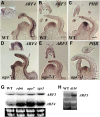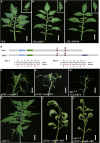Failure of the tomato trans-acting short interfering RNA program to regulate AUXIN RESPONSE FACTOR3 and ARF4 underlies the wiry leaf syndrome
- PMID: 23001036
- PMCID: PMC3480288
- DOI: 10.1105/tpc.112.100222
Failure of the tomato trans-acting short interfering RNA program to regulate AUXIN RESPONSE FACTOR3 and ARF4 underlies the wiry leaf syndrome
Abstract
Interfering with small RNA production is a common strategy of plant viruses. A unique class of small RNAs that require microRNA and short interfering (siRNA) biogenesis for their production is termed trans-acting short interfering RNAs (ta-siRNAs). Tomato (Solanum lycopersicum) wiry mutants represent a class of phenotype that mimics viral infection symptoms, including shoestring leaves that lack leaf blade expansion. Here, we show that four WIRY genes are involved in siRNA biogenesis, and in their corresponding mutants, levels of ta-siRNAs that regulate AUXIN RESPONSE FACTOR3 (ARF3) and ARF4 are reduced, while levels of their target ARFs are elevated. Reducing activity of both ARF3 and ARF4 can rescue the wiry leaf lamina, and increased activity of either can phenocopy wiry leaves. Thus, a failure to negatively regulate these ARFs underlies tomato shoestring leaves. Overexpression of these ARFs in Arabidopsis thaliana, tobacco (Nicotiana tabacum), and potato (Solanum tuberosum) failed to produce wiry leaves, suggesting that the dramatic response in tomato is exceptional. As negative regulation of orthologs of these ARFs by ta-siRNA is common to land plants, we propose that ta-siRNA levels serve as universal sensors for interference with small RNA biogenesis, and changes in their levels direct species-specific responses.
Figures







Comment in
-
Why wiry? Tomato mutants reveal connections among small RNAs, auxin response factors, virus infection, and leaf morphology.Plant Cell. 2012 Sep;24(9):3486. doi: 10.1105/tpc.112.240911. Epub 2012 Sep 21. Plant Cell. 2012. PMID: 23001038 Free PMC article. No abstract available.
Similar articles
-
Genome-wide analysis of leafbladeless1-regulated and phased small RNAs underscores the importance of the TAS3 ta-siRNA pathway to maize development.PLoS Genet. 2014 Dec 11;10(12):e1004826. doi: 10.1371/journal.pgen.1004826. eCollection 2014 Dec. PLoS Genet. 2014. PMID: 25503246 Free PMC article.
-
Ectopic expression of SlAGO7 alters leaf pattern and inflorescence architecture and increases fruit yield in tomato.Physiol Plant. 2016 Aug;157(4):490-506. doi: 10.1111/ppl.12425. Epub 2016 May 3. Physiol Plant. 2016. PMID: 26847714
-
Dicer-like2b suppresses the wiry leaf phenotype in tomato induced by tobacco mosaic virus.Plant J. 2023 Dec;116(6):1737-1747. doi: 10.1111/tpj.16462. Epub 2023 Sep 11. Plant J. 2023. PMID: 37694805
-
Molecular basis of plant architecture.Annu Rev Plant Biol. 2008;59:253-79. doi: 10.1146/annurev.arplant.59.032607.092902. Annu Rev Plant Biol. 2008. PMID: 18444901 Review.
-
RNA commutes to work: regulation of plant gene expression by systemically transported RNA molecules.Bioessays. 2001 Dec;23(12):1087-90. doi: 10.1002/bies.10027. Bioessays. 2001. PMID: 11746226 Review.
Cited by
-
The complex of ASYMMETRIC LEAVES (AS) proteins plays a central role in antagonistic interactions of genes for leaf polarity specification in Arabidopsis.Wiley Interdiscip Rev Dev Biol. 2015 Nov-Dec;4(6):655-71. doi: 10.1002/wdev.196. Epub 2015 Jun 24. Wiley Interdiscip Rev Dev Biol. 2015. PMID: 26108442 Free PMC article. Review.
-
Developmental Genetics of Corolla Tube Formation: Role of the tasiRNA-ARF Pathway and a Conceptual Model.Plant Cell. 2020 Nov;32(11):3452-3468. doi: 10.1105/tpc.18.00471. Epub 2020 Sep 11. Plant Cell. 2020. PMID: 32917737 Free PMC article.
-
Genome-wide identification, molecular cloning, expression profiling and posttranscriptional regulation analysis of the Argonaute gene family in Salvia miltiorrhiza, an emerging model medicinal plant.BMC Genomics. 2013 Jul 29;14:512. doi: 10.1186/1471-2164-14-512. BMC Genomics. 2013. PMID: 23889895 Free PMC article.
-
A spontaneous thermo-sensitive female sterility mutation in rice enables fully mechanized hybrid breeding.Cell Res. 2022 Oct;32(10):931-945. doi: 10.1038/s41422-022-00711-0. Epub 2022 Sep 6. Cell Res. 2022. PMID: 36068348 Free PMC article.
-
The Multiverse of Plant Small RNAs: How Can We Explore It?Int J Mol Sci. 2022 Apr 2;23(7):3979. doi: 10.3390/ijms23073979. Int J Mol Sci. 2022. PMID: 35409340 Free PMC article. Review.
References
-
- Adenot X., Elmayan T., Lauressergues D., Boutet S., Bouché N., Gasciolli V., Vaucheret H. (2006). DRB4-dependent TAS3 trans-acting siRNAs control leaf morphology through AGO7. Curr. Biol. 16: 927–932 - PubMed
-
- Allen E., Howell M.D. (2010). miRNAs in the biogenesis of trans-acting siRNAs in higher plants. Semin. Cell Dev. Biol. 21: 798–804 - PubMed
-
- Allen E., Xie Z., Gustafson A.M., Carrington J.C. (2005). MicroRNA-directed phasing during trans-acting siRNA biogenesis in plants. Cell 121: 207–221 - PubMed
Publication types
MeSH terms
Substances
Associated data
- Actions
- Actions
- Actions
- Actions
- Actions
- Actions
- Actions
LinkOut - more resources
Full Text Sources
Molecular Biology Databases
Research Materials

